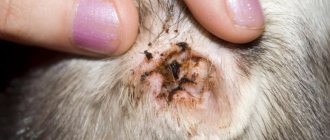The cat was bitten by a tick, what should I do?
Of course, you should remove it as soon as possible. The ixodid tick itself does not pose a serious problem, but the infection it can carry can have dangerous consequences. Of course, not all insects are carriers of infections, but still, treatment should not be delayed.
There are different types of mites, with different symptoms, however, the treatment methods for all of them are almost the same. It is important to understand that before you try to remove a tick from a cat, you need to get all the necessary information about how to do it. Self-indulgence in treatment can cause serious harm!
How to spot a tick and what it looks like
It is quite difficult to confuse a tick with other insects, but if you have never encountered one before, here are their distinctive features:
- Their body looks like a drop, which can have the following colors: black, gray or brown. It is especially easy to detect a parasite that has drunk blood; its body grows several times and it is not difficult to notice the parasite.
- Three or four pairs of legs protrude from their body.
- The parasite has a proboscis on its head. Ticks bury their heads down and it is impossible to notice them in this state. If the tick has just landed on the cat’s body, is tangled in the fur, or has not yet had time to attach itself, then you can easily understand what you managed to protect your pet from.
Before the parasite drinks blood, the parasite's body will be small in size, which will significantly complicate its search on the pet's body. Some characteristic signs of a tick bite, such as itching, can help.
But it’s better not to wait for symptoms, but to check everything yourself. To do this, you need to carefully palpate your pet. Most often, they can be felt in tender parts of the body, such as the neck, groin, head or ears.
It would be a good idea to check other parts of the body, such as the back. Just because a tick prefers soft places doesn’t mean it can’t attach itself to other places. However, in soft places, as close to bare skin as possible, it is much more common.
A more effective detection method is to comb the cat's fur. Run the comb through the fur, but very carefully and slowly so as not to accidentally disturb the tick and not give it a reason to crawl deeper.
What not to do
The Internet is full of “helpful” tips on methods for removing ticks, and sorting through them all would take forever. But this is not necessary, if the cat was bitten by a tick, then first you need to understand a few simple points:
- Do not let your cat scratch or bite you in the affected area. The insect may burrow even deeper into the cat's skin, making it more difficult to remove the parasite.
- Do not try to reach the tick with your hands. This is pointless and will lead to deeper burying.
- A very popular folk method of getting rid of a tick is to drip an oil solution into the parasite so that it dies without oxygen. The tick will indeed die, however, the process of getting it out will not become any easier. In addition, the tick will not die immediately, and will continue to secrete infected saliva until its death.
- Do not try to remove a tick with a needle. By piercing an insect with a needle, you are unlikely to be able to kill it with one hit, but you will help it begin to burrow deeper.
- It is a very bad idea to try to squash a parasite. By squashing a tick, you can encourage the remains of its body to fall into the open wound after the bite, which can cause infection. In addition, if you crush a tick, its head will remain in the cat's body.
Veterinarian advice
Domestic cats that are not outdoors are not 100% protected from tick bites. The parasite can enter the home on a person's clothing or shoes. Preventive measures and regular weekly examination of your pet will allow you to detect a bite in a timely manner.
Inexperienced owners may mistake a cat's nipple for a tick, which in appearance resembles the body of a gorged tick. Before you begin removing the parasite, you should make sure that it is he.
Do not throw away a sucking tick. Having laid eggs, it will reproduce offspring that will continue to spread infections.
All information posted on the site is provided in accordance with the User Agreement and is not a direct instruction to action. We strongly recommend that before using any product, you must obtain a face-to-face consultation at an accredited veterinary clinic.
How to remove ticks from a cat at home
The parasite must be removed immediately after detection. The sooner you get it, the less likely it is to infect your cat. But you need to get it out correctly. Removing ticks from cats is not the easiest or most enjoyable process, but it is still quite doable at home.
To remove an insect, you do not need a special device for removing ticks; improvised means will do. It is necessary to treat the parasite with alcohol or an alcohol-containing product, for example, oil, gasoline, acetone, or varnish. You can then use any of the following methods:
- Using tweezers or a clamp. You need to pick up the tick right at the base - that is, as close as possible to its head. After fixing it with the device, start twisting it clockwise or counterclockwise, as is more convenient. The tick needs to be twisted out, and not pulled out sharply;
- Pull it out using thread. Place a loop around the parasite and twist it out.
If the cat's head remains under the skin
You can understand that the tick's head remains in the body by examining the bite site in more detail; a black dot on it indicates that the head remains in your cat's body. Also indicating the presence of a stranger may be the fact that the place where the bite was made remains a lump, often red or pink.
To remove the excess fragment of the insect you will need a needle. Treat it with alcohol to disinfect. Then imagine that the head of the parasite with its proboscis is a splinter, and pick it out in the same way, only carefully so as not to harm the cat.
Advice: if you are not confident in your strength and are afraid that you will not be able to remove the insect yourself, you should immediately contact a specialist.
Is it more difficult to remove a tick from a kitten?
The process of extracting a parasite from a kitten is no different from an adult. But the consequences are much more serious. The kitten's immunity is very weak.
Syringe
The syringe is used very rarely. The fact is that it will be ineffective when the blood sucker is sucked very tightly, the vacuum created will not be able to remove it. Also, the syringe is rarely used, due to the wool, which prevents the creation of that same vacuum. If you decide to try this method, you will need to trim the hair at the site of the bite.
You need to take the syringe and cut it off from the needle side. This needs to be done as carefully as possible to get the smoothest edges possible. Next, place the syringe against the skin at the site of the bite and pull the plunger several times, thus creating a vacuum, which pushes the bloodsucker out of the wound. After the procedure, do not forget to treat the wound.
Treatment after parasite removal
After removing the tick, you need to properly treat the bite site. Since the treatment is being done at home, you can get by with the remedies that are available in every home: iodine, brilliant green, hydrogen peroxide, alcohol. It is important to treat around the wound, and not the wound itself, so that there is no burn or tissue damaged by the bite.
Prevention of bites
Precautionary measures are primarily necessary for cats whose owners let them go outside. There are several ways to keep your pet safe:
- collar;
- drops;
- sprays.
Anti-tick medications for cats in the form of sprays are considered the safest, but their duration of action is very short. Collars that use truly effective products are not recommended for long-term wear.
The most effective tick repellent for cats is drops. The best brands of drops sold by veterinary pharmacies include: “Clandestine”, “Stronghold”, “Bars”, “Inspector”.
However, we must not forget that there is no panacea for protection against parasites, and drops do not always protect, like other means. Therefore, you should not neglect examining your cat.
Prevention of infection
As an additional precaution, you can get vaccinated. If your cat has been bitten by a tick and has contracted the infection, vaccination will help develop immunity against the disease.
Prevention
There is no vaccination that can protect a cat from tick bites. Let's look at how to get rid of ticks in other ways. You can protect your animal using preventive measures (sprays, drops, collars, shampoos, etc.) and compliance with safety measures.
The most dangerous periods are considered to be April-June and August-October. The way ticks hunt is to “fall” onto the victim from high areas of grass, bushes, and tree branches. Ticks cannot jump, but they move from one animal to another when they come into close contact.
To minimize the risk of encountering ticks, you should limit your pet’s walks during periods of parasite activity, choose areas with artificial turf for walking, and also avoid contact with other animals.
Why are ticks dangerous for cats?
As has already been written many times above, a tick bite in a cat is the cause of infection with diseases. Among the most dangerous are tick-borne encephalitis and piroplasmosis. The incubation period for these diseases is 2–4 weeks.
The consequences of a bite can be very tragic, so veterinarians warn owners that if their pet exhibits lethargic and unusual behavior after a bite, they should immediately seek help from specialists.
Piroplasmosis
Piroplasmosis is a disease that can kill a cat in ten days if no measures are taken. The disease disrupts the functioning of the animal's internal organs. Has the following symptoms:
- blood impurities in stool;
- elevated temperature;
- diarrhea;
- vomit.
If left untreated, the disease progresses rapidly. The disease can be treated, but under no circumstances should we delay.
Encephalitis
A disease that affects the brain. May cause paralysis, loss of vision or death of the cat. Residents of the Far East should be especially careful, where every fifth tick is a carrier of the encephalitis virus. The disease has the following symptoms:
- weakness;
- convulsions;
- unsteady gait;
- lack of appetite;
- vomit;
- diarrhea.
The disease occurs in several progressive stages. There is no special remedy for the treatment of tick-borne encephalitis in cats. But the disease is still treatable, you just treat the symptoms. The cat is also given antiviral agents and antibiotics.
Preventive measures
It is always better to prevent a situation than to look for solutions later. To do this, you need to be careful about protecting your cat. You can purchase a spray or collar at any pet store or veterinary pharmacy; they will protect your pet from insect attacks. You can consult your doctor before purchasing.
In order to avoid complications, you should take vaccination responsibly, that is, do all vaccinations in a timely manner. This attitude of the owner towards his animal will protect him from sad consequences. And even with a tick bite, from which no one is protected, the risks of infection are reduced to zero.
What mistakes should you not do?
Due to possible infection, all procedures that involve contact with insects must be carried out only with gloves. If there are none, you can wrap your fingers with a bandage or any cloth.
Everyone is familiar with the method when an insect is doused with oil, kerosene or other oily liquid. It is believed that the oily liquid will block the air supply, the tick will suffocate and can be easily removed. This method is very dangerous for the animal and should not be used.
The fact is that the parasite can indeed suffocate and die, but you also need to be aware of possible complications. When he doesn’t have enough air, he will go deeper into the wound even further. In addition, in a stressful situation, he will secrete a large amount of saliva, which contains the infection. Therefore, in this case, we, on the contrary, expose the cat to greater danger.
Do not make sudden movements, do not pull, do not jerk the insect. If you tear it out, fragments will remain in the wound. This is quite dangerous, because if they are not removed, inflammation and rot will develop, which leads to serious consequences.
You cannot crush them, because the liquid that is in their digestive system, just like saliva, contains infection. Contact with human or animal skin can lead to infection.
Danger to the animal
Everyone knows the danger these parasites pose. When an infected tick bites, it transmits the virus to its victim. The diseases they transmit are very dangerous for the animal and without proper treatment can lead to death. If you have removed it and want to find out whether it is infected, you need to put the bloodsucker in a hermetically sealed container and take it for tests within 2 days.
The animal’s symptoms do not appear immediately; the animal’s health should be monitored for a month. Symptoms vary depending on the disease, and quite severe allergic reactions can also occur.
The infected animal becomes weak, appetite decreases, and as a result, weight decreases, drowsiness, mucous membranes become pale, temperature rises, and the color of urine changes. If you have any symptoms, you should immediately contact your veterinarian.
The most common diseases include theileriosis, tularemia, and hemobartonellosis. Each of them is treatable, but it is very important to diagnose them in the early stages.











